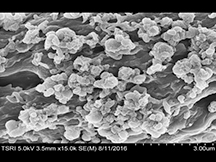One Cytokine To Control Multiple Cytokines
By Jim Schnabel
Cytokines are a big family of signaling proteins that activate a host of processes in cells. Much remains unclear about how cytokine signals are dialed down or switched off. But scientists at The Scripps Research Institute (TSRI) have just discovered an efficient mechanism evolved by Nature: At least one member of the cytokine family has the ability to act as a “checkpoint” regulator that blocks the actions of many other cytokines.
The researchers revealed this mechanism in experiments with the cytokine interferon gamma (g), showing how, in different contexts, it shuts down the signaling activities of multiple other cytokines. The finding hints that this same, one-stops-many principle will be found not just elsewhere in the cytokine realm but also in other signaling-molecule families.
“This may represent a new paradigm in cell biology,” said senior investigator Kyungmoo Yea, an assistant professor of cell and molecular biology at TSRI.
The finding by Yea and his colleagues, published on July 31 in the Proceedings of the National Academy of Sciences, also sheds light on the specific mechanisms through which interferon g blocks multiple cytokines. Knowing these mechanisms may give researchers new opportunities for drug therapies for cytokine-related diseases.
The cytokine family comprises hundreds of signaling proteins, including the interferons and interleukins, which are perhaps best known for their roles in immunity and inflammation. These tiny, cell-to-cell messengers often work in powerful, positive-feedback cascades, in which one cytokine stimulates cells to produce other cytokines, which then reciprocate by stimulating production of the first, and so on.
Precisely how cytokine cascades are blocked or switched off is an unresolved question in biology, and an important one, given cytokines’ central roles in crucial processes—from fighting infections to steering cell development.
In considering the problem recently, Yea reasoned that cytokines are unlikely to have their own counterpart family of regulator proteins, such that each regulator blocks the activity of a single cytokine.
“It just wouldn’t be economical to have all those extra genes in the genome, given that cytokines work via overlapping pathways and signal transduction mechanisms,” Yea said. “It seemed more reasonable for us to assume that the regulators of cytokines are other cytokines.”
To test this hypothesis, Yea and colleagues, including co-senior author Richard Lerner, the Lita Annenberg Hazen Professor of Immunochemistry at TSRI, and first authors Zhao Zha and Felicitas Bucher, both research associates, set up an experiment to determine which cytokines block the activities of other cytokines.
In cultured test cells, the researchers injected small viruses carrying the genes for 209 different cytokines—such that each cluster of cells expressed one cytokine.
“We first selected cells on whose activities and functions a cytokine had a clear impact: what we call a phenotype,” Yea said. “Then we systematically challenged that type of cytokine-expressing cell with other cytokines to determine if any of them could block the phenotype.”
For their initial test cells, the scientists used dental pulp stem cells, which are found in the fleshy cores of teeth. The researchers found that whereas several different cytokines can induce dental pulp stem cells to become a more mature type of cell called an odontoblast, applying interferon gblocked this phenotype every time.
Some other cytokines showed a phenotype-inhibiting effect, but none was nearly as potent as interferon g. The team showed that in a completely different context—in lung-based cells called fibroblasts—interferon g again could block the effects of several other cytokines.
“We therefore suspect that interferon g has a general role as a master cytokine checkpoint regulator,” Yea said.
How does interferon g manage to shut down the activities of a diverse set of other cytokines? The TSRI researchers found that it does so in two basic ways.
Firstly, it boosts the production and activation of a cellular signaling protein called STAT1. The latter competes with and blocks another protein, STAT3, a major element in ordinary cytokine signaling, and thus serves to reduce that signaling.
Secondly, and more potently, interferon g effectively dismantles the receptors through which many other cytokines transmit signals to cells. Even though different cytokines signal via different receptors, many of these receptors have a common subunit called gp130. The researchers found that interferon g prompts cells to internalize gp130, thereby deactivating multiple cytokine receptors all at once.
“The fact that interferon gamma works by modulating a component shared by many cytokine receptors probably helps explain how it functions as a master regulator,” Yea said.
In further experiments, the TSRI scientists found evidence that interferon g works as part of a negative feedback mechanism at the level of the individual cell—so that its action is triggered directly by the process it is supposed to block, such as cellular differentiation.
Aside from illuminating the basic biology of cytokine signaling, the findings hint at the existence of other cytokines—and other types of signaling protein—that also work, via similar mechanisms, as master checkpoint regulators. Yea and Lerner and their colleagues are now following up with studies to find more of those.
Other co-authors of the study, “Interferon-γ is a master checkpoint regulator of cytokine-induced differentiation,” were Anahita Nejatfard, Tianqing Zheng, and Hongkai Zhang, all of TSRI at the time of the study.
Funding for the study was provided by JPB Foundation and Zebra Biologics.
Send comments to: press[at]scripps.edu














